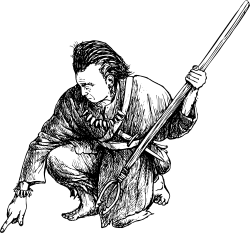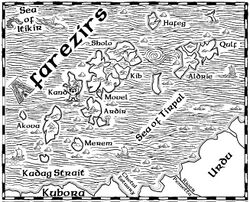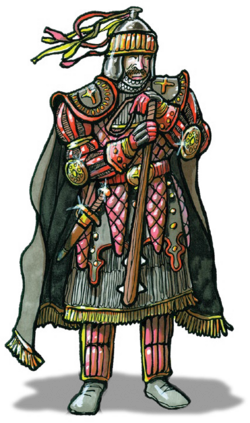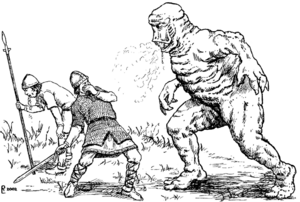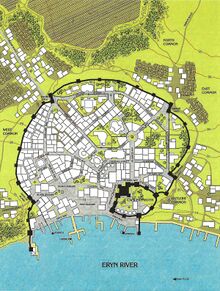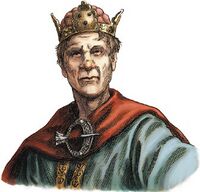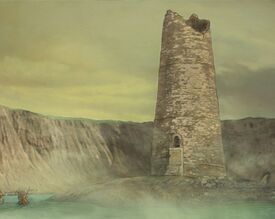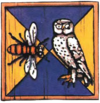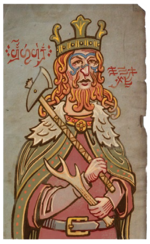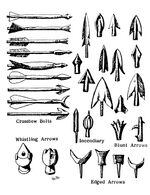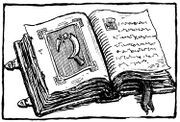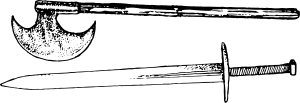Hârndex
A[edit | edit source]
| Realm: Orbaal | Holder: Clan Taaresaar |
| Population: 325 | Tribute: Vaagel |
Built by the Jarin in 430, Aaldem was captured by the Ivinians in 674. The valhakar is Burlni Taaresaar, a porcine and intelligent young man of 25. The Taaresaars are a branch of clan Taares from Menglana in Ivinia and are related to the royal clan of Orbaal.
| Realm: Kaldor | Holder: Rekela of Nurez |
| Population: 170 | From: Serekela of Kaldor |
Abriel is the seat of the Rekela (bishop) of the Laranian diocese of Nurez in Kaldor. Abriel is also the Hundred Moot of Nelafayn Hundred and a commercial center of agriculture. Rekela Ilor Hadan, a capable and pious man who cares little for temporal affairs, despises his duties as Bailiff of the Hundred and leaves them to the abbey’s high priest. The bishop’s theological beliefs manifest themselves in meticulous attention to dogma and ritual, eschewing the martial glory sought by his peers. His obsession with theology has weakened Laranian military strength in Meselyneshire and his message threatens to polarize the clergy.
Heraldic arms including escutcheon (shield), mantling, mount, helm, supporters, wreath, scroll, and crest. Called a coat of arms only if on a coat. See Heralds.
The chief herald of Kaldor resident at the Enclave of the Holy Oak in Tashal.
The tribal nation inhabiting the Island of Anfla. The Adænum are organized into about twenty, culturally indistinguishable tribes, varying in size between fifty and four hundred. Their inefficient agricultural techniques cause rapid soil depletion prompting tribes to move every few years. Villages will be reused. by the same or another tribe, about every fifteen to twenty years; a given site will not often be lived in for more than two to three years. Adænum village contain a mixture of permanent wooden frames but animal hide walls are portable. The Adænum also heard sheep, goats, ponies and a few cattle.
The highest peak, 8,865 feet (2,702 m) of the Jahl Mountains.
A faction of the Jarin resistance movement based at Gedan. Led by Gweffryn of Seylnes, the Aenghysa engage in sabotage and assassination directed against Ivinians and Jarin collaborators. They are associated with an obscure Ilviran sect, the Order of Chuchlaen Wheelwright, which has a secret temple at Gedan.
Four prophets of Peoni, one each from the north, south, east, and west, whose pilgrimage and meeting in Perna around 600 BT founded the Church of Peoni.
An archipelago of fifty-eight, hilly forested islands northwest of Hârn between the seas of Tirpal and Itikir. The Afarezirs have many fine natural anchorages, mainly fjords. Several attempts have been made to colonize the islands but no permanent settlements remain.
The present era of Hârnic history, which began with the arrival of Hârn's first human settlers, the Jarin, just over 2,000 years ago.
The three millennia, from c.10,000 BT to c.7,000 BT, between the Lost Years and the Codominium. This was a “golden age” when the Sindarin, with their deity Siem, dwelt alone on Hârn.
The 6th and last Autarch (668-674) of the Thardic League. Since the founding of the Thardic League in 636, the power of the Autarchs had grown to a quasi-imperial status. Many league senators became uneasy with this trend and Aglir did little to appease them. Without the approval of the two senates, Aglir involved the League in the Salt War with Kaldor and when this war was lost in 673, Aglir’s enemies sought to discredit and depose him. Aglir responded by panning a military coup which failed only because he was assassinated by members of his own guard in 674. With his death, the office of Autarch was abolished and the Thardic Republic was formed.
The 6th month of the year by Tuzyn Reckoning, named after the god Agrik. Agrazhar is the last month of summer.
Agrik, the God diametrically opposed to Larani, is the principal deity of warriors who enjoy the dark side of war: rapine, pillage, cruelty, and destruction. It is said that the pious adherent of Agrik will learn as many of the “Ten Thousand Ways” (of inflicting pain) as possible.
Agrik dwells in his great flame-shrouded fortress of Balgashang among his attendant bat-winged, cloven-hooved, fireenshrouded, hook-clawed, demonic servants called V’hir. Somewhere within the castle is Ak-Syt, the dreaded chamber of tortures. It is here that unspeakable demons practice the “ten thousand ways” on the hapless, unlamented dead. The location of the fortress is uncertain; some believe it to be at the center of Kethira. Agrik usually appears to mortals as a great V’hir with two claws missing from his left hand, bearing Gashang, his flaming mace, and Sycanus, his ichor-dripping sickle. His missing claws have caused him constant pain and anger since the goddess Larani severed them. Never forgetting this ancient indignity, only the terms of the Concordat of the Illimitable Tome deter Agrik from seeking revenge. Some believe that Agrik will eventually attempt to assassinate the goddess regardless of the consequences; there is certainly no love lost between the fighting orders of the two deities.
The worship of Agrik on Hârn is concentrated in the Thardic Republic and the Kingdom of Rethem but there are a few followers in Orbaal and elsewhere. In Chybisa, Kaldor, Kanday, and Melderyn, it is a proscribed faith that carries the penalty of death by burning, an ironic punishment for adherents of the god of fire. The ritual garb of Agrik’s clergy is orange and black. Human sacrifice is practiced, often in ritual combat with a champion of a fighting order.
On Hârn, seven clerical sects are devoted to the worship of Agrik; each sponsors its own fighting order. Dogmatic differences between the orders may be few but they constantly squabble, often with fatal consequences for innocent bystanders. Although he has great difficulty maintaining his authority, the primate of Agrik for Hârn is currently the grandmaster of the Order of Mamaka, Master of Steel, whose seat is in Golotha. The Amanasurif (pontiff) dwells in Lysara in Azeryan, where he is also a powerful secular lord.
| Titles in the Agrikan Church | |
|---|---|
| Amanasurif | Pontiff |
| High Curcuno | Senior Cardinals |
| Low Curcuno | Junior Cardinals |
| Apalankh | Primate |
| Kemelras | Bishop |
| Viriahn | High Priest |
| Aperan | Temple Master |
| Ulankh | Free Priest |
| Herucha | Temple Lieutenant |
| Agnichar | Acolyte |
| Senesharil | Clerical Order Grandmaster |
| Markithra | Deputy Grandmaster |
| Akarata | Fighting Order Grandmaster |
| Tenaka | Deputy Grandmaster |
| Meketa | High Commander |
| Telmen | Commander |
| Dotelen | Subcommander |
| Haragki | Knight |
| Ainlaumak | Corporal |
| T’kelan | Sergeant |
| Laumak | Soldier |
The Agrikan clerical orders active on Hârn and their sponsored fighting orders are:
The fourth constellation (Nolus 4th–Larane 4th) of the Kethiran zodiac, Ahnu is located in the northern sky.
The dragon symbolizes the cleansing destruction of fire. What the smith brings forth, Ahnu destroys. This is not necessarily wanton destruction, for Ahnu cleans and prepares the world for renewal, an ordeal that purifies, that destroys the unworthy and the superfluous, and makes room for the new.
Those born under Ahnu are perfectionists, which is both a strength and a weakness. They dislike and cannot find room for fault. Ahnuans tend to be intolerant and impatient; they have quick and violent tempers. They are slow to praise, quick to criticize. They are not fond of the conservative or the old and solid, but tend towards experiment and progress. Often they are radical revolutionaries prone to purge rather than correct.
A tax levied by a feudal lord on his tenants. In the case of a Royal Aid, the sovereign demands payment from his tenants-in-chief, who in turn demand it from their tenants, and so on down the line until the peasants end up paying for everything. Aids are traditionally levied when the lord wishes to knight his eldest son, marry his eldest daughter (for the first time), or ransom his person from enemies. Special aids, such as to finance a war or build a castle, may also be levied, although this practice is (except in Rethem) normally the sole preserve of kings. See also Heriot and Merchet.
The fifth king (307-342) of Kaldor.
The seventh ruler (362-377) of Kaldor. Aidrik II was clearly the legitimate successor when Maranos died. But the increase in roll power propagated by his predessecors caused many of the Karldoric barons to support the rival claim of Fierth. The Kaldoric Civil War was the result and Aidrik II was betrayed and captured in a battle near Kiban in 377. According to popular legend, Aidrik and his family were roasted over an open fire by the usurper but his son, at least, survived to regain the throne in 406 (see: Restoration).
The tenth king of Kaldor (406-425). Prior to his capture by Fierth the Usurper in 377, Aidrik II made provisions for his heir’s safety by sending him to Chybisa “for his education”. The young man waited patiently, perhaps indulging in some intrigues. The excesses of Fierth the Usurper and of his son and successor Uthred outraged the Kaldoric barons, and with Uthred’s assassination in 406, young Aidrik was invited to resume his father’s throne. He took the title Aidrik III to symbolize the tradition and legitimacy of his rule while renaming his dynasty the House of Artane to symbolize a new start for his subjects. His reign was marked by conciliation and compromise; a profound relief to most of his barons.
The eleventh monarch to govern Kaldor (425-451) and the second of the House of Artane. Aidrik IV furthered this father’s (Aidrik III) policy of reconciliation after the Restoration but also subtly reverted to the trend of increasing royal lower that had caused the Kaldoric Civil War. He was succeeded by his daughter Myselbane.
The sickly son of Queen Chelebin I, who lived to reign over Kaldor for only two years (516-518). Aidrik V was the kingdom’s fourteenth sovereign. He was succeeded by his younger sister Chelebin II.
A non-zodiacal constellation of the southern sky.
Shoulder armour made of plate or kurbul, often secured by leather thongs and decorated with heraldic devices. Fairly rare on Hârn.
According to legend, an alliance of monsters that came “from beyond the stars to wage war upon the Earthmasters…and as the Ancients stood for peace and beauty, so the invaders cared only for war and destruction.” The greatest appeal of the legend is that it explains the disappearance of the Earthmasters.
The “Torture Chamber of the Gods”, a domain of the god Agrik. Ak-Syt is, of course, not the torture chamber of all deities, since many of them dislike such practices. It is here that unspeakable demons practice the “ten thousand ways” on the hapless, unlamented dead. Located beneath the fortress of Balgashang, the name Ak-Syt is used as a synonym for “hell”.
A headland in Orbaal jutting into the Sea of Itikir.
The Aklash is a great, hulking, semi-intelligent creature, best known for its foul breath. Ranging 6–8’ in height and 300–400 lb in weight, the Aklash’s hairless body is covered by rolls of pale fat that heal over with alarming rapidity. Although possessed of great strength, its main weapon is its breath, which it can exhale with considerable power to cause profound nausea in most victims. With its huge, fanged mouth, the Aklash has a voracious, omnivorous appetite.
The third largest island of the Afarezirs.
The priestess of Peoni who performed the marriage ceremony of the Aerlathos and may have become the first pontiff.
A ritual of the Laranian church that only priests attend. Held every five days.
The castle of Ambrathas.
A hallucinogenic plant found primarily in heathland.
The fabled “lost city” of the Hârnic elves, said to have been the seat of King Daelda. Many Sindarin, Khuzan, and human legends refer to its existence, although the tales are vague on details such as its appearance and location. Hundreds of attempts by human adventurers to find Alarienel have been unsuccessful and treasure maps purporting to show its location are common frauds. If Alarienel exists on a physical plane at all, the most common sites mentioned are Pesino and Ridow, although some believe the city is in Faya on Yashain.
The founder and first monarch (316-371) of the Kingdom of Aleathia. Very little is known about Alash. As a chieftain of the Aleta, Alash unified them into a single tribe c.350. He founded the city of Aleath and, some six years later, the Kingdom of Aleathia. It has been written that Alash was a “gentle man, fond of things beautiful and harmonious,” an assessment no doubt based on the heritage of Aleath, but it is unlikely that such a man could have unified the Aleta or persuaded them to make him their king.
A legendary warrior of Jarin folklore.
A custodian and expounder of civic law and member of a town court. The office is not heritable but children often succeed their parents, since this is how customary law is passed from one generation to the next. Most towns have 12 aldermen, usually prominent guildsmen, often members of the Litigants’ Guild.
An island in the Afarezirs.
| Realm: Kanday | Status: Freetown |
| Population: 5,800 | Charter: King of Kanday |
Aleath is the fifth-largest settlement of Hârn and the largest in the Kingdom of Kanday. A seaport at the mouth of the River Eryn, Aleath is somewhat isolated from the rest of western Hârn. Aleath’s hinterland is only moderately fertile but still possesses a fairly dense population. Boat-building and fishing are significant. The townsfolk pride themselves on their high standards of architecture and civic cleanliness, although Aleath is outstanding only by Hârnic standards. The streets are regularly patrolled and the city is regarded as one of the safest spots on Hârn. Aleathians tend to regard outsiders as morally bankrupt, while they themselves are often deemed self-righteous, prudish snobs.
The city is a freetown, governed under royal charter by a mayor and 12 aldermen proposed by the Mangai and appointed by the king. Military authority is shared by a royal constable and the Sheriff of Eryna (see Kedis). There is also a town militia that is theoretically commanded by the mayor, but the custom has been to surrender this authority to the constable. The city charter includes 8,000 acres of adjacent cropland, a legacy of the old Republic of Aleath. This land is farmed by approximately 140 freeholders who pay taxes to the city.
Aleath has a troubled past. The city was founded in 356 by Alash, a chieftain of the Aleta. For a century, the city prospered as the capital of the Kingdom of Aleathia, its wealth second only to that of Coranan. In 453, the Kingdom was incorporated into the Corani Empire and Aleath continued to prosper. Its port was expanded and a paved road was built, linking it with the north. The city became known throughout the empire as the “fairest city of man.” Between 551 and 559, the entire empire suffered a series of plagues and famines that fostered the Balshan Jihad. With the fall of Coranan to the armies of the jihad in 565, Aleath, the only untaken city, declared itself a republic and gathered the surviving loyalists to its bosom. This First Aleathian Republic lasted for seven years before the city fell to the Balshans after a bitter three-year siege in 572. Some Aleathians fled by sea, undertaking the Aleathian Odyssey (see Thay), and many others slew themselves rather than witness the “Agony of Aleath,” the terrible bloodbath that was to follow the city’s fall.
The city reluctantly became a part of the Theocracy of Tekhos in 572 and suffered its share of religious purges and spectacles. Following the collapse of the Theocracy in 588, Aleath suffered from the chaos, along with everyone else, but gradually gathered power to establish a second republic in 612. Slowly extending the city’s benign influence over the nearby petty states, the republic hoped for a new liberal age. Weakened by decades of war, however, Aleath’s strength was inadequate to the task. With rumors of barbarian invasions in the north, the Aleathian senate chose the least of several evils. In 633, the republic voted its crown to the ascendant King of Kanday, Andasin II, in return for a liberal charter recognizing its rights as a freetown.
The following temples are found in Aleath:
| Halea | Order of the Silken Voice |
| Larani | Order of the Hyvirk* |
| Peoni | Order of the Balm Joy |
| Peoni | The Irreprochable Order* |
| Save-K’nor | The Hyn-Aelori |
* Headquarters of the Order.
The city of Aleath has formed two republics during its history. The first lasted seven years (565-572) after the demise of the Corani Empire, ending with the city’s fall to the Theocracy of Tekhos. The second republic was formed in 612 to restore order during the Interregnum; it was abolished in 633 when it voted to join the Kingdom of Kanday.
A kingdom founded in 356 by Alash, chieftain of the Aleta tribe. After a 97-year existence, under five monarchs, Aleathia was incorporated into the Corani Empire in 453. Aleathia’s monarchs were:
The sea voyages of Aleathian fugitives from the Theocracy of Tekhos, (572-573). A month before the City of Aleath fell to the Tekhosians, 400 nobles, priests, soldiers, artisans, merchants and farmers, chosen by lot, and most children under the age of 12, boarded a motley fleet of some 50 ships and sailed eastward into the Gulf of Ederwyn, with the aim of founding a new Aleath. The expedition was organized over a period of several years by clan Melesen, originally immigrants from Melderyn. Written accounts of the Odyssey describe horrific weather and fanciful sea monsters. The foul weather of the Gulf broke the fleet into small flotillas; many vessels disappeared without trace. Legends about stray ships, have them founding colonies at various, likely and unlikely, spots. Fully half of those ships who set sail from Aleath were lost. The rest eventually managed to assemble at the island of Keboth where they were succoured by the the Sindarin. There (or possible before, the records are ambiguous) the refugees met with Genin, a mage of Melderyn, and under his guidance, they sailed through the Indatha Straits to found the city of Thay in 573.
The second monarch (692-714) of the Kingdom of Orbaal.
The third and current monarch of the Kingdom of Orbaal. Alegar came to the throne in 714 (six years ago), and is faced with a host of problems trying to govern his unstable kingdom. This has been compounded by a recent threat from the “homeland” of Ivinia, which regards Orbaal to be a colony and seeks to be paid unspecified annual tribute.
A tribal nation inhabiting the southwest of Hârn some 500 years ago. The Aleta were unified under the chieftanship of Alash, and this led to the foundation of the Kingdom of Aleathia in 356.
The “foreigners’ quarter” of Cherafir. Separated from the rest of the town by a fortified wall, most of Cherafir’s foreign trade occurs within the Alienage. It is an unruly place with a thriving black market.
A Sindarin weaponcrafter of the Codominium, Alorin was the best friend of Raldir Farizhald, a Khuzan weaponcrafter of similarly great renown. Their unwavering friendship is the subject of “Lament for the Passage,” a well-known Hârnic legend.
The chief servants of Save-K’nor, the Althar are the nine Judges of the High Archive.
One of the Althar, servants of Save-K’nor. Other than the god himself, Althea is the only entity able to carry Uhla, the black lantern. By the unseen light of Uhla, all secrets are revealed.
An ancient warrior-priest of Larani, credited with being her greatest mortal champion.
This gargun complex is located in an abandoned Khuzdul mine. With more than 1,300 Gargu-kyani, Amekt is the largest Kyani colony on Hârn and, with the possible exception of Pujet, the most peaceful. Although in a position to threaten travel between Lorkin, Leriel, and Geldeheim, the orcs of Amekt rarely trouble human settlements or travelers.
The free undead of Morgath. When an Amorvrin is slain for the thirteenth time, it is resurrected as a will-less Gulmorvrin.
A rough highland extension of the Sorkin Mountains lying between Horadir and the Plain of Thay. Anadel has no peaks higher than 6,000 feet (1,800 m) and is predominantly covered with mixed forest. Anadel isolates Thay from the rest of Hârn. Only one major road, the Genin Trail, bisects the region. Anadel is the range of the Bujoc tribesmen.
A tax levied in most ports for the right to drop anchor. It is usually one fifth of the local wharfage fee.
(see Earthmasters)
The first monarch (589–627) of the Kingdom of Kanday. Andasin was the head of clan Kand, minor nobility of the Corani Empire, which achieved prominence after being outlawed by the Theocracy of Tekhos in 575. The clan established itself in exile in the Mimea Hills, from where it harassed the forces of the government and sheltered other enemies of the state despite several attempts to exterminate them. When the Theocracy collapsed, Andasin captured the keep at Ibonost from its Tekhosian governor in 589, founding the Kingdom of Kanday. This was followed with the capture of Edino in 598 and Dyrisa in 620. An impressive castle, Dyrisa is now the principal seat of Kandian kings. A devout follower of Larani, Andasin founded the Order of the Checkered Shield in 622, which subsequently captured Quivum, Heroth, Ewen, Zerien, and Imiden for the young kingdom. Andasin began a sad decline into senility around 624 and died in 627.
The second monarch (627–654) of the Kingdom of Kanday. Andasin II was the grandson of Andasin I, whose sons had all died in battle. He was a peaceful man who established a Kandian tradition of enlightened kingship. More prone to negotiation than war, Andasin II made many alliances with bordering petty states and convinced the Aleath Republic to join with Kanday as a freetown in 633. By the time he died in 654, Kanday was a strong vigorous kingdom and its gentle influence had spread throughout most of southwest Tharda.
The fifth monarch (676–690) of the Kingdom of Kanday, Andasin III succeeded the childless Queen Arelora. His claim to the throne was somewhat tenuous. He was the son of Melise, the bastard daughter of Kubro, the second son of Andasin I. He soon found himself waging the desperate war with Rethem known as Ezar’s War (682–697). Andasin conducted the early war with skill but was killed in 690 while leading the successful recapture of Hebon.
The eighth and current monarch of the Kingdom of Kanday. He is a learned but weak ruler, dominated by his father, the Earl of Sarkum, the former prince consort.
A body of water west of Hârn, noted for sudden, frequent, westerly storms from the Haonic Ocean.
The major peak 7,648 feet (2,331 m) of the central Rayesha Mountains.
The third-largest of the Hârnic isles, Anfla is separated from the mainland by the Emaba Strait. The western margins are heathland while the rest is mixed forest and woodland with small patches of cropland/pasture created by the indigenous Adaenum.
The fifth constellation (Larane 5th–Agrazhar 6th) of the Kethiran zodiac, located in the northern sky.
The swords represent dynamic action and conflict, destruction and surprise. Angberelius is depicted as two weapons crossed, from which flames are issuing. While the swords are solid and real, their conflict causes fire, which is intangible but no less real. They are the symbol of maleness, light, strife, and glory, of victory that arises from piercing, cutting effort.
Those born under Angberelius tend to have exciting lives in which they are always striving against their environment to promote causes. This is the sign of the action-loving warrior questing for his grail. If he finds it, he may well experience disappointment, as it’s watery contents quell his personal fires. Angberelians are not prone to subtlety, except the subtlety of combat; they prefer the direct approach, taking arms against their troubles and, by opposing, ending them.
The goddess Larani’s legendary blood-red mail.
A short, swift river flowing from Lake Direna in the Felsha Mountains to Lake Benath.
A site of Earthmaster origin at the northern end of Direna Lake in the Felsha Mountains. The site’s environs are quite heavily forested but the visible buildings seem well preserved. There are extensive passages beneath these structures.
A village to the west, Haruch, is linked to Anisha by an extensive network of game-trails. The village’s inhabitants, the Mendar-Haruchi tribe, claim descent from the servants of Anisha’s original inhabitants, who were, according to their legends, godlike in their abilities. They consider the ruins sacred and believe it their duty to preserve and protect them for their masters’ anticipated return. Highly superstitious, the Mendar do not themselves practice magic beyond a little folk medicine. The village subsists on hunting and lake fishing and has a population of just more than 200.
The tribal inhabitants of northern Nuthela, related to the Taelda in the south of this region. They are descended from Jarin peoples but have interbred with other folk. The Anoa are nomadic and subsist on hunting, fishing, and gathering, and robbing the Orbaalese. Since they are often the object of punitive expeditions from Lorkin and Leriel, and because their neighbors are mainly gargun, they build no permanent settlements. When possible, the Anoa trade the region’s abundant furs for various civilized implements. There are several dozen tribes, whose numbers rarely exceed a hundred each.
A marshland at the mouth of the Anoth River with more than a score of islands. The vegetation is mixed woodland. In the summer, the delta is infamous as a breeding ground for mosquitoes and other disease carrying insects. It is also noted as a base of operations for Esobran, a wrecker, brigand, and erstwhile pirate. His band is mostly of Jarin extraction and ranges in number from 10 to 100, larger when crops are bad, smaller when times are good. Esobran preys mostly on Ivinian ships and settlements.
A river fed by the glaciers of Mount Obew, flowing generally north and east to empty through the Anoth Delta into the Sea of Ivae. The Anoth, considered the border between Orbaal and Nuthela, has a broad alluvial plain, richly endowed with mixed forest. There are no bridges on the river but it is often fordable below its confluence with the Etece.
A hilly prominence on Hârn’s northeast coast jutting into the Sea of Ivae. Somewhere in the vicinity there are said to be a pool and hot springs (possibly subterranean) of miraculous healing virtue. Unfortunately for those who would avail themselves, the springs have a guardian, one of the Pradeyalkri called the Riddlemaster. It is the practice of this entity to challenge intruders with the words “riddle thee thrice.” Those who can solve any of the three conundrums posed are permitted to bathe, but depart under a geas never to reveal the Riddlemaster’s secrets, including that of his appearance. The fate of those with whom the master finds fault is unknown.
| Realm: Orbaal | Holder: Clan Fyrdael |
| Population: 335 | Tribute: Marby |
A fortress built by the Jarin in 562 and captured by the Ivinians in 658. The present valhakar is Arlaas Fyrdael, who is 33. The Fyrdaels are a junior branch of clan Fyrda from Seldenbaal in Ivinia.
Apothecaries have a monopoly on the gathering, preparation, and sale of herbs and medicines for profit. Most freemasters operate shops where they purchase herbs from itinerant journeymen and other professional gatherers. These are sold to the general public as potions and remedies, or to physicians (who, technically, are not allowed to prepare their own concoctions) and to members of the Guild of Arcane Lore. Most herb prices range from 3d to 60d per ounce depending on rarity.
The twelfth king of Melderyn (440–463) and the thirteenth ruler of Chybisa (440–463). Arabar I was the fourth king of the Rylian Dynasty. In accordance with the tradition already in place in Melderyn, he tended to leave most of the governing to his councillors and vassals. Almost nothing is known of the man personally.
The fourteenth ruler (475–538) of the Kingdom of Melderyn. Despite his bastardy, Arabar was chosen by the succession council to succeed his father Erebir V under the kingdom’s vague laws of succession. The nobility of the former kingdom of Chybisa, however, declared that they were outraged at such a travesty and promptly seceded, electing king Sharat I]] to govern them. Arabar does not seem to have been particularly abashed at this profound insult. After issuing a proclamation denying Chybisa’s right to secede, he ignored the matter entirely and got back to the business of quiet, efficient government of Melderyn.
Hârn’s third-largest lake, located in the heart of the Sorkin Mountains, fed and drained by the Nephen River. The Khuzan kingdom of Azadmere lies along its eastern shore. Rich in minerals and often mirror-like in its tranquility, Arain has spiritual significance to the Khuzdul. As with most Hârnic lakes, several unverified sightings have been made of a serpentine creature known as the Daranog cavorting in the moonlight. Surrounded by high mountain peaks and colored deep blue in the sunlight, Lake Arain ranks as one of the fairest sights on Hârn.
A huge limestone sinkhole located in Misyn. According to legend and the doctrine of the Ilviran church, Araka-Kalai is the dwelling of the god Ilvir. An ancient tower stands on a rocky island in the center of the Pit of Ilvir, surrounded by a liquefied, fermenting sludge with a stench that puts to shame all other offensive smells. Beneath this crumbling tower, in dank, endless caverns, the Accursed Lord of the Barren Cycle is said to spawn his “fatherless multitude” the Ivashu.
Obviously, Ilvirans deem Araka-Kalai to be highly sacred. Every year some 200–300 hardy followers of this mystic religion make an arduous pilgrimage to the site, mostly via Leriel but sometimes via Shiran across or around Lake Benath. Roughly one half league northwest of the Pit is an Ilviran religious community called Ochrynn, a temple and hostel complex run by the Order of the Ochre Womb. This isolated settlement of about 100 priests and common folk prospers by catering to pilgrims and, surprisingly, to traders seeking Ivashu for the Pamesani. A small renegade group called the Dark Order, vehemently opposed to this latter policy, broke away from the Ochre Womb some years ago and is said to inhabit the miles of natural caverns that interconnect with Araka-Kalai. Since the Dark Order was formed, many of those involved in the lucrative Ivashu trade have met with violent death or have mysteriously disappeared.
The greatest religious festival of the Church of Ilvir takes place from Yaelah to Yaelmor in the month of Ilvin. Araksin is one of very few universal practices in the church. Priests fast for a week before, usually in solitude. The festival features original dramatic presentations as well as those drawn from the rich Ilviran tradition.
The ruling dynasty of the Kingdom of Rethem, founded by Puril in 681 and currently headed by King Chafin III. The House of Araku replaced the house founded by Arlun the Barbarian in 635 and known today as the Kuboran Dynasty. Given the nature of Rethemi politics, lengthy ruling dynasties are unlikely.
The second constellation (Peonu 4th–Kelen 2nd) of the Kethiran zodiac, located in the northern sky.
The second and central sign of spring and earth, the wands are portrayed with leaves sprouting from their severed lengths, symbolic of the quiet tenacity of life. The symbolism is more pure than that of Ulandus, more the essence of growth than its effect and corollaries.
Aralius’ secret is the hidden life within, the potential of all things to nourish in life and in death. Aralians generally display a vibrant zest for life but recognize that death is a part of it. This may not be apparent to outsiders. Aralians also have an affinity with nature, of which they are harmonious parts. Aralians often center their lives on the family and strive for future generations. They may perceive their children to be manifestations of themselves, a key to personal identity and immortality, and windows on eternity.
The present king of the Sindarin, Aranath has reigned since King Daelda received his mortal wound at the Battle of Sorrows c.683 BT. One reason that Aranath (Daelda’s nephew) was selected was that many of Daelda’s kin had fallen while fighting the barbarians and most others chose to leave Hârn for the Blessed Realm. One of Aranath’s first acts was to renounce his sovereignty over all of Hârn. He withdrew his folk to the Shava Forest, where they established the Kingdom of Evael. For 1,400 years, Aranath’s wisdom and powers of enchantment have kept his folk and his kingdom safe.
An island off the west coast of Orbaal.
| Realm: Orbaal | Holder: Clan Cyeen |
| Population: 405 | Tribute: King of Orbaal |
A castle dominating the island of Arathel. Built by the Jarin in 530 and captured by the Ivinians in 673, the original keep was expanded into a castle between 685 and 690. The Cyeen clan has some Jarin blood, which may account for their relative gentleness to their subjects. They are related to the Kyrodwes of Wethom. Valhakar Tursi Cyeen is an energetic man of 46. The Cyeens have made several unsuccessful attempts to establish colonies to the west. In 710, a small colony on the shore of Morvilya Bay was annihilated by Equani tribesmen. Tursi’s youngest son was slain in the massacre. Arathel receives tribute from Pjagel, Vold, and Wethom.
A loose association of scholars whose studies and practices involve esoteric knowledge. Some arcanists practice magic (see Shek-Pvar) some are students in obscure but mundane fields. The distinction is often obscure. The guild grants no franchises and there is no fixed structure. There may be apprentices and journeymen, but such is at the discretion of individual masters or chantries. Those who practice the hidden arts are far too involved in their studies to take much notice of outsiders. This is a weak guild with some very powerful members.
The court of Save-K’nor in Inor Teth. It is here that disputes between the gods are arbitrated.
The fourth largest of the Afarezirs.
The fourth monarch (659–676) of the Kingdom of Kanday. Queen Arelora is best remembered as the “warrior queen.” During the Five-Year War with the Thardic League, she assumed command of the Kandian army after its defeat at the Battle of the Teb Marshes in 663. Bedecked in silver armour and with stirring speeches to her demoralized troops, the 52-year-old queen led her army to victory at the Battle of Eidru in 665 and captured Kuseme Castle for Kanday. Some say she would have conquered Coranan itself but for the barrier of the Thard River. Arelora’s victories and charisma forced the League to sue for peace, ending the war in Kanday’s favor in 666. Arelora, the widow of the former King Ashenan, died childless in 676, succeeded by Andasin III.
One of the Althar, the chief servants of Save-K’nor, Argenon is the Lord of Enigmas, a creator and solver of riddles. The Riddlemaster of Anrist Point may be one of his numerous offspring.
An ancient tribe who lived in the region around Dyrisa. Dyrisa was a holy place to the Ariathe, and more than 80 chieftains are buried in barrows there. Considerable plundering has taken place, but it is now illegal to desecrate the site.
| Realm: Rethem | Holder: Companions of Roving Doom |
| Population: 460 | Liege: King of Rethem |
Arketh was built in 604 on the site of a ruined Corani Empire fortress by the Companions of Roving Doom, perhaps the most violent of the Agrikan fighting orders. Although their sponsoring clerical order, the Pillar of Fire, has been largely exterminated because of internal conflict in the Church, the Companions remain powerful and active in Rethemi affairs. The grandmaster, Bremel of Kawaran, a staunch loyalist of Chafin III, rules the fief with conspicuous brutality.
The founder and first monarch (635–656) of the Kingdom of Rethem. Around 625, the Kubora nation of Peran, some 90 tribes, were united under Arlun, a chieftain of great personal charisma and skill at arms. Convinced of a higher destiny, Arlun trained his followers in the arts of war and prepared to invade and conquer the south, then in chaos during the Interregnum. Arlun’s hordes swept down into Rethem in 629 and, after six years of brilliant strategy and maneuver, succeeded in conquering all of this region, including the city of Golotha. Arlun then founded the Kingdom of Rethem in 635, using Shostim as his capital. Until his death in 656, Arlun sought to further expand his empire but found that resistance from Kanday and the Thardic League could not be overcome. At its peak, Arlun’s kingdom was second only to the Corani Empire in size. It was, however, drastically reduced when Arlun was succeeded by men of much less capabilities.
| Realm: Orbaal | Holder: Clan Hulthard |
| Population: 365 | Tribute: Lorkin |
Built as a Jarinese keep in 495, Arone was captured by the Ivinians in 663. Zaarli Hulthard is an elderly man in poor health. The clan is a branch of clan Hulthard from Rogna in Ivinia. Arone has a fine harbor and offers cheap refuge to seafarers. The Hulthards have covert dealings with pirates in the Anoth Delta.
The fifth monarch (366–380) of the Corani Empire. Some say Mejenes the Great was the greatest military leader Hârn has ever produced; others say it was Arosta the Conqueror. Both were very successful military leaders. Arosta succeeded his father, Raelan, who was killed at the Battle of Klondis in 366. The Corani Empire might have perished then, for Raelan not only got himself killed but also lost most of the Corani army in the mountains of Hefiosa. Led by Adjak, the tribes of Hefiosa advanced on Coranan but wasted time looting, gaving Arosta time to raise and train a new army. In a series of brilliant campaigns, Arosta first defeated the Hefiosa tribes between 366 and 369, then defeated the Shira, Kom, and Merdi tribes over the next 10 years. When Arosta died in 380, he was planning to conquer the Kingdom of Aleathia in the southwest. He left to his heir a kingdom that had more than tripled in size and that ruled most of Tharda.
Most arrows are pointed, with or without barbs, and mounted on thin wooden shafts 24 to 36 inches in length. These are designed to create puncture wounds and can be frighteningly effective. There are also specialized arrowheads, including bladed (edged) arrows designed to cut rigging, blunt arrows to stun, incendiary arrows, and whistling arrows to signal or intimidate.
The ruling house of Kaldor from 406 to 599. The clan was a branch of the house of Tane and assumed power after the overthrow of the house of Orgael in the Kaldoric Civil War.
Arva is a climbing vine found growing on the trunks of trees in semi-shaded woods and heath. Its seed pods are used in the preparation of several strength potions.
The insane governor of Dyrisa during and for some time following the Theocracy of Tekhos. Asagran had a reputation for unusually cruel torture, cannibalism, and even necro-cannibalism. Asagran was murdered in 609 by his chief deputy.
| Realm: Orbaal | Holder: Clan Atejaal |
| Population: 525 | Tribute: Marby |
Built by the Jarin in 609, Asax was captured by the Ivinians in 659. Hjarn Atejaal is 51, a survivor of the Cape Renda disaster. He is coarse, violent, and prone to insane bursts of temper. The Atejaals are related to clan Tejaal of Menglana in Ivinia.
The third monarch (654–659) of the Kingdom of Kanday. Ashenan succeeded his brother, Andasin II, but died after only five years on the throne. Little can be said about him other than he had the good sense to marry Arelora, who became Kanday’s first queen on his death.
Any of a variety of minor ethereal spirit entities whose elemental base is air. The Asiri are believed to exist all over Hârn, where they secret themselves in various objects. They possess diverse powers (usually minor) and can be mischievous or downright troublesome. Most Asiri can only be detected with psionic or magical powers. They are similar to the Elmithri.
Land within a manor recently cleared and brought under cultivation. Assarting is the principal method of “colonization” within a feudal fief.
Lady Calfona Astrin was a leading authority on feudal etiquette. Her Manners and Affectations (398 TR) is the definitive volume on classifying arms and armour.
Astrology is the ancient art of reading the stars to explain the lives and foretell the futures of men. The art has been practiced for many centuries by arcane orders in Melderyn, most of whom use Pvaric philosophy in their work. Astrologers can cast a person’s horoscope, a comprehensive picture of the heavens at the precise sidereal hour of their birth. When cast by a skilled master, horoscopes reveal personality and the probable outcome of certain personal events with remarkable accuracy. Because such castings are time-consuming and expensive, most Hârnians rely on the more basic fundamental traits established by the 12 signs of the zodiac.
The divination of specific future events by means of astrological arts is known as astromancy. Although few astrologers attempt to predict more than general trends, astromancers are more specific. However, even they try to avoid demands by clients for too precise prediction.
The Sindarin name for the Lythian barbarian conquest of Hârn (900–683 BT). The wars began as minor raids but gradually increased as the Lythians settled on Hârn with a view to conquest. The Atani Wars ended with the Battle of Sorrows in 683 BT, in which the Sindarin defeated the barbarians. However, the elven king, Daelda, suffered a mortal wound. As a result, Daelda’s successor, Aranath, withdrew his folk to the Shava Forest, abandoned his Khuzdul and Jarin allies, and renounced his kingship over Hârn. This act allowed the Lythian barbarians to recover from their defeat and complete their conquest of Hârn.
| Realm: Kaldor | Holder: Sheriff of Vemion |
| Population: 275 | Liege: King of Kaldor |
A royal keep and the shire moot of Vemionshire. Athelren was first built in 50 TR by an early Jarin kingdom and was rebuilt in 250. The Sheriff, Sir Tulath Kaphin, a bastard son of the king, is considered to be a wastrel, although he has somewhat reformed since his recent marriage to a daughter of Baron Verdreth of Ternua.
A region of generally rough terrain between Lake Benath and the Gulf of Chakro. As the principal corridor between eastern and western Hârn, the region is of strategic importance. Athul is claimed by the Thardic Republic and is theoretically part of Ramala Province, but control is slight. The Ramala Legion constantly skirmishes with the native Tulwyn, a mercenary collection of ruthless tribesmen who have resisted all attempts at subjugation.
The Aulamithri are tiny ethereal beings, one of the types of spirit folk known as Ilsiri. Like other Ilsiri, they are non-corporeal but become visible to mortal eyes under moonlight. Unlike other Ilsiri, the Aulamithri have sworn loyalty to Siem and serve him by carrying dreams, messages, and forgetfulness to the mortal races.
The demi-divine children of Sarajin and mortal women.
The legendary sword of the goddess Larani, also known as “Herald of the End of Life” and “Oathbinder.”
| Realm: Kanday | Holder: Sheriff of Selion |
| Population: 530 | Liege: King of Kanday |
A royal keep and the moot of Selionshire. Avertu was built in 509 as a naval base of the Corani Empire. The Sheriff, Sir Jens Demilaen, is distressed by the growing power of the Earl of Sarkum and his influence over Andasin IV. Sir Jens regards himself as the greatest loyalist of the House of Kand but feels that the present king is something of a disappointment.
| Realm: Azadmere | Holder: King of Azadmere |
| Population: 5,900 (4,100 Khuzdul, 1,800 Human) |
The major settlement of the Kingdom of Azadmere and seat of the ruling clan Tarazakh. It is an impressive walled city, with a moat, stout double walls, and prominent round towers. The city is built along the shore of Lake Arain, hemmed against Mt. Zaduryn. As is the custom with the Khuzdul, extensive chambers and passages have been carved into the living rock of the mountain. Very few humans have seen the spacious halls within. Most of the Khuzdul reside in this inner city, while human citizens live in the outer city or in nearby villages.
The kingdom of the Hârnic Khuzdul is centered on the city of Azadmere but includes most of the mountains surrounding Lake Arain. The kingdom was founded more than 7,000 years ago but was once smaller than the ill-fated sister kingdom of Kiraz. The total population is 11,000, of which 6,200 are human, descendants of a few hundred trusted Jarin who were given refuge after the Atani Wars. Most of the humans live around the settlement of Habe. The kingdom also includes the impressive Zerhun fortress.
Although a few adventurous and outlawed Khuzdul may be found anywhere on Hârn, Azadmere has minimal contact with outsiders. The kingdom does import some of its food from Kaldor in exchange for cunningly wrought artifacts. It is deemed a great honor for an outsider to be permitted entry to the kingdom.
Hazmadul III, the leader of the royal clan Tarazakh, is an energetic Khuzdul of middle age who came to the throne in 658. The kings of Azadmere for the last 13 centuries have been:
- Hazmadul I 456–361 BT
- Harazul I 361–361
- Karasat 208–164
- Dhazalad 164–73
- Zarhul 73–47
- Ohin 47–12 TR
- Harazul II 12–37
- Tarthin 37–155
- Karinazul 155–257
- Hazmadul II 257–390
- Dunazak 390–524
- Lharzin 524–547
- Erasath 547–658
- Hazmadul III 658–present
A great empire on the mainland of Lythia, Azeryan lies east of Trierzon, centered on the mighty city of Mekolis. Azeryan is an imperial state ruled by a great emperor whose legions are feared far and wide.
The seventh month of the year by Tuzyn Reckoning is named after the Azure Bowl, a symbol of the god Siem. Azura is the first month of autumn.
A highly mystical symbol of the god Siem and of his religion. Sindarin legends, old even when they first reached Hârn, describe the artifact as being connected with “the making, the holding, and the very spilling forth of the stars.” If the original Azure Bowl ever existed, no mortal has ever seen it. There have been several facsimiles constructed and it is these to which most now apply the term. Although many Azure Bowls are undoubtedly the work of charlatans and of only aesthetic interest, others are authentic “gazing bowls.” If one of these is filled with clear water (any special requirements are ambiguous), “visions” are apt to occur while gazing within. However, the spiritual fiber of the gazer, and possibly that of observers, may be altered. In view of the connection with Siem, such changes are probably benign.
B[edit | edit source]
On Hârn, a bailiff is either a person appointed to run a manor on behalf of the owner, or the assistant to a Sheriff. If the former, a bailiff will manage the fief either for a fixed stipend or a percentage of the revenues and will reside in the manorhouse. If the latter, a bailiff will probably be one of several bailiffs in a shire responsible for royal justice in a subdivision of the shire, usually called a “hundred.” His formal title will then be “Bailiff of the Hundred” and he will reside in a manorhouse owned by the king.
An archipelago off the northeast coast of Orbaal in the Sea of Ivae. The largest island, Kereva, is inhabited. Numerous reefs make the islands hazardous for seafarers.
The early history of the Church of Agrik, the Chronicle is the legacy of Ilpylen, the first prophet of Agrik. It was written by Moralin, the greatest of Ilpylen’s eight disciples.
The twenty-third monarch of the Kingdom of Chybisa. Balesir succeeded, almost by default, when the tragic death of Udine II brought an end to the House of Burzada in 664. The first ruler of the new House of Geledoth, perhaps through no fault of his own, became involved in the Treasure War with Kaldor in 675. After long years of peace, Balesir’s Chybisan army was no match for the Kaldoric knights and Balesir soon found himself besieged in Burzyn. Balesir held out until 678, when plague and rebellion forced him to surrender. Receiving honorable exile from King Torastra of Kaldor, Balesir and his few vassals journeyed to Melderyn, where the outcast king was finally able to raise an army in 686 after promising his fealty to Melderyn’s King Chunel. At the battle of Geda in 687, Balesir won back his throne but then broke his promise to swear fealty to Chunel (an act for which Verlid VII, Balesir’s successor, still has ulcers). Balesir himself died of stomach cramps in 691.
The legendary flame-shrouded fortress of the god Agrik and his minions, possibly located at the center of Kethira and said to be the location of Ak-Syt.
A good natural harbor and anchorage at the mouth of the Beldel River on the Isle of Keron. Sandy beaches allow shallow-draft vessels to be dragged ashore for repair. An Ivinian settlement was established in 704 before the planned attack on Thay but was mysteriously destroyed by a freak storm in 707. The anchorage is still occasionally used by mariners plying Hârn’s east coast.
A shire of the Kingdom of Kaldor. The Shire moots are held at Shebra, the keep there being held for the king by the Sheriff of Balim.
A flail with a metal ball attached to a handle by a short length of chain. Numerous varieties exist, including some with multiple spiked balls. See Flails.
The celibate, female order of the church of Peoni. The mother house located in Thay is the residence of the Peonian primate of Hârn. There are subsidiary temples in Aleath, Coranan, Cherafir, and Tashal, as well as hundreds of unmanned rural shrines dotted throughout civilized Hârn. The sisters of the order are beloved and welcomed by common folk of good heart. Each temple has an infirmary that is open to anyone of reasonable morals on a “pay as you can” basis. The sisters spend most of their labors among the people, providing comfort and healing. The order abhors violence and most members would rather die than cause suffering. The sisters tend to be aesthetic vegetarians but there is no rule to this effect. The Irreproachable Order is the fraternal male equivalent of the Balm of Joy.
Born to a common soldier of the Corani Empire in the Province of Rethem in 520, Balsha was the most important religious personality in the history of Hârn. His preaching of Balshanism, his charismatic personality, and the accuracy of his prophesies, won him a massive following. The emperor Medak had Balsha impaled in 558 but his martyrdom fostered the Balshan Jihad, a rebellion that destroyed the Corani Empire in seven bloody years. Some have suggested that Balsha was a renegade Melderyni mage, but this is unlikely.
The rebellion triggered by the execution of Balsha in 558 and which by 565 had engulfed and destroyed the Corani Empire. The jihad led to the founding of the Theocracy of Tekhos in 568.
A variation of the dogma of the Church of Morgath, espoused by and named for the prophet Balsha. Morgathian philosophy teaches that the afterlife is an eternity of misery and that one should live only for today. Balshanism argued that since the worldly existence of most was in itself misery, to avoid eternal misery, one must serve Morgath well today and receive the rewards of a grateful deity, with “half-life eternal.” In effect, Balshanism argues that worship of Morgath during one’s lifetime will moderate the misery of the afterlife, creating a state of eternal “undeath,” now and forever.
The lowest hereditary title of nobility on Hârn, ranking below Earl. A baron’s fief is called a barony and usually contains a keep and about 20 manors. Roughly 70% of these will be held by vassal knights and the rest held by his appointed bailiffs.
A 120-foot waterfall on the Kald River. Uvien, one of the Pradeyalkri and a master of elemental water, is said to dwell nearby. Uvien’s residence may or may not be submarine, but is at least well hidden.
| Realm: Kaldor | Holder: Constable |
| Population: 660 | Liege: Earl of Minarsas |
A keep in Meselyneshire on the east bank of the Kald. Baseta was originally fortified before the Migration Wars (c.140 TR), when it was part of the Kingdom of Nurelia. The present keep dates from the sixth century. A local legend relates that the ghost of Prince Brant, the last prince of Nurelia, was murdered here and haunts the site. The constable of Baseta is Sir Eres Tereneth, a robust and jolly man said to keep one of the finer tables and cellars in Meselyne.
Any hand-and-a-half sword between 40” and 48” in length. Bastard swords have longer hilts than broadswords and their name derives from the fact that they may be used either one or two handed.
The last battle of the Atani Wars in BT 683. Although the Sindarin and their allies won the battle over the Lythians (the Atani), King Daelda was mortally wounded. His successor, Aranath, withdrew the Sindarin to the Shava Forest and established the Kingdom of Evael.
A single- or double-bladed axe mounted on a shaft about 48" in length. The battleaxe is a hand-and-a-half weapon with considerable blunt and edge impact.
Any large, two-handed sword. Most battleswords have broad, straight blades 48–60” in length, but there are regional variations. They are chivalric weapons and somewhat uncommon.
| Realm: Rethem | Holder: Warriors of Mameka |
| Population: 380 | Liege: King of Rethem |
A fief held by the Warriors of Mameka, an Agrikan fighting order. The keep was built in 699 TR, allegedly on land granted by King Nemiran. No legal title seems to exist; it is likely the land was seized from its legal holder during the turmoil caused by Ezar’s War. The grandmaster is Horab Gerund, a sadistic and corpulent sensualist.
Bejist is located on Setha Heath, two leagues inland from the Belna Strait. A mysterious, foreboding place, its location is known only to a few. The site has buildings from three different periods in various states of repair. These include an Earthmaster structure, extensive ruins of an Atani War–era Sindarin prison, and a recent temple built and occupied by a renegade sect of Naveh known as the Cult of Aedlad the Imprisoned. The surrounding terrain is unappealing at best, mostly windswept heath with numerous and treacherous bogs. The Navehan clerics suffer no interlopers; trespassers they catch are unlikely to have a pleasant memory of their visit.
Although it is commonly believed that the Sindarin King Daelda died of wounds he received at the Battle of Sorrows c. 683 BT, he is actually “imprisoned” at Bejist in a chamber hidden by great enchantment. For 12 centuries, Daelda has been engaged in a great struggle with the demon Aedlad, his evil alter ego. The Navehan clerics seek the prison of Aedlad, but do not understand the significance of their quest.
| Realm: Rethem | Holder: Baron Orgatt |
| Population: 260 | Liege: King of Rethem |
A baronial seat in Parachshire. The keep was built in 653 by Arlun the Barbarian and granted to clan Orgatt by King Nemiran in 673. The Orgatts have considerable Kuboran blood, something Branal, the present baron, tries to hide. Branal is regarded as a pliable idiot, easily manipulated by the king.
An island to the south of Setha Heath. The windward margins are hilly heathland but the island is mostly mixed forest and woodland. Belna is the home of the Chymak.
The strait separating Belna Island from Setha Heath. The western entrance is hazardous due to reefs and shoals.
One of the demi-divine servants of Peoni, Belsirasin is portrayed as a weeping young warrior without weapons. He is said to shed tears for every deceit of mortal man. A lord of truth and virtue, Belsirasin is the most stern and least forgiving of Peoni’s servants.
Hârn’s largest lake is fed by rivers of the Felsha and Rayesha Mountains and drained by the Thard River. The few small islands are uninhabited. The lake is important to Shiran’s prosperous fishing industry and is a source of some raw materials for the town’s famous perfumeries. The lake is normally quite calm but can become very rough during southwesterly storms. Lake Benath has the usual legends of fearsome monsters, but only a particularly nasty type of stinging freshwater eel is known to exist.
A plant found in shady forest, berilik is used to make a battlefield anesthetic.
The Ivinian name for a byrnie, an armoured shirt or hauberk.
| Realm: Kaldor | Holder: Sheriff of Neph |
| Population: 425 | Liege: King of Káldôr |
A royal keep and the moot of Nephshire. The keep was built in 430 TR and is urgently in need of repair. The cellars have a tendency to flood during spring run-off and the foundations are showing signs of weakening. The sheriff is the Baron of Getha.
The most northerly of the Hârnic Isles, inhabited only by seals and sea birds.
(see Poleaxe)
A cape projecting into the Sea of Ivae north of the Anoth Delta.
The central river of Solora, which flows from the Anadel highlands to the Indatha Straits. The river passes through the heart of the Solori tribal lands.
A shire of the kingdom of Melderyn. The shire moot is at Racyn, where the Sheriff of Biren holds the keep on behalf of the king. Theoretically, Birenshire includes the Solora wilderness region.
The legendary “wind demon” of Mount Fyso.
(see Uhla)
(see Durakhar)
To extract a payment in exchange for the armour of a defeated opponent. Mercenary knights are sometimes called blackmailers because poorer knights preserve their mail by soaking it in oil, rendering it black.
A verbal description of an heraldic achievement or device. Blazonry is the art of describing heraldic devices.
The euphemistic name (the real name is unknown) of the present home of Siem. The Sindarin were, at the time of their arrival on Hârn, headed for this realm, lying “far to the west.” Periodically, groups of Sindarin set sail for the Blessed Realm, which almost certainly lies beyond the bounds of Kethira, through a “gate” that opens only to Siem’s command.
A cheerful domestic spirit of Jarin belief, fascinated by the hearth fires of human homes and believed to bring good luck. However, if the Bogaern is ignored or abused by its chosen family, it causes complete chaos, even to the extent of wrecking the house or terrorizing entire settlements.
A great mage, alchemist, and herbalist of the Fyvrian convocation who dwelled in the Anoth Delta. Bognor and his household were destroyed by one of his experiments, providing the Shek-Pvar with a teaching parable known as “Bognor’s Folly.”
An arm of the Gulf of Andurien at the mouth of the Thard River.
When anyone brings trade goods into a settlement with a market, they must either purchase a hawking license to permit sale of the goods or place the goods in bond at an authorized bonding house. Hawking fees are one-time payments of generally 8–10% of the goods’ value. Bonding fees are charged monthly and are typically 1–3% of goods’ value. Goods placed in bond are usually re-exported but may be taken out of bond on payment of the appropriate hawking fee. Goods are not always inspected, and bribery, undervaluing, and graft are common.
The official responsible for the administration of a bonding house, and the collection of hawking and bonding fees. Appointed by the mayor or aldermen, the bondmaster is usually a guild member.
(see Cottar)
A spike affixed to the boss (raised central portion) of a shield to give a thrusting option to its wielder. They are most often found on roundshields. Although shields are not good attack weapons, the boss gore can be effective against lightly armoured opponents in close combat.
Many different types of bows are used in Lythia. The shape of a bow is a cultural matter. What really matters is the bow’s size, which determines its range and accuracy. In general, the larger the bow, the more powerful it is. Bows are generally used as hunting weapons or employed en masse by foot archers to break up enemy formations. (See Longbow, Shortbow, Crossbow, Hartbow.)
The third king (172–207) of Nurelia’s only ruling house, clan Ethelyen. Brant guided his kingdom skillfully through much of the Migration Wars. He was succeeded by Nurelia’s last king, Lotin the Grey.
The uncrowned heir to the last king of Nurelia, Prince Brant was captured during the Kaldoric conquest. The young prince was confined in Olokand and later disappeared. Most folk suspect murder, possibly by being cast into the pit known as Ona-Setrum on the orders of King Kalabin of Kaldor.
Another name for the Shadow of Bukrai.
Any one-handed sword 30–40” in length. Broadswords are usually double-edged with broad, straight blades, but there are various regional variants. The broadsword is, by far, the most popular weapon of the feudal nobility of western Lythia.
| Realm: Kaldor | Holder: Church of Peoni |
| Population: 115 | Liege: King of Káldôr |
The Peonian monastery at Bromeleon was built by the Irreproachable Order in 420 with a grant from King Aidrik III of Kaldor. It is a contemplative community that serves as a retreat for itinerent priests, ranking clergy, and high-born benefactors. Pelnala (high priest) Rablar Oppias is an inspiring spiritual leader who excels at spiritual and theological training and resolution of disorders of the soul. The subordinate manor of Poynter is a hospice for lepers and their families.
Also known as the Taleweaver, Bronduschithrin is one of the Althar, the chief servants of Save-K’nor. He has charge of fiction and legend; his repertoire of stories is limitless.
| Realm: Kaldor | Holder: Rekela of Serelind |
| Population: 245 | From: Serekela of Kaldor |
Brynd is the seat of the Rekela (bishop) of the Laranian diocese of Serelind in Kaldor. Rekela Verda Emerel, an elderly man in failing health, has been a steadying influence on the church, carefully mediating between the archbishop and the dogmatic Rekela Hadan of Abriel.
A small shield, usually strapped to the secondary wrist. Bucklers are generally of light construction, allowing them to move faster than larger shields, but they are less durable.
A nation of shy, superstitious forest nomads with a strong matrilineal culture. Their tribes, some 30 in number, rarely exceed 100 in strength. They gather twice each year for a summer and winter moot, the latter in the hills overlooking Telumar. Inheritance and lineage are traced through females and Bujoc women play a subtle but dominant role in tribal affairs. They sit in council and often settle tribal disputes among themselves. The male chief of any tribe always acts on the advice of his wife, the Sha woman. She is the real power in the tribe, although this will not be apparent to outsiders. When the chief dies, his wife takes a new husband who becomes the new chief. When the Sha woman dies, the chief will take “the long walk.” Her eldest daughter (usually) will become the new Sha woman, and her husband the new chief. The Bujoc do not see marriage as a sexual institution; any woman may summon to bed any unmarried male, or a married male with permission of his wife. Only the women are aware of the connection between sex and procreation. The Bujoc are not very warlike, but if forced to fight, they will employ bow and arrow from ambush.

